Developing Individuals, Teams and Organisations Report - HR Module, UK
VerifiedAdded on 2020/10/22
|16
|4322
|375
Report
AI Summary
This report analyzes the development of individuals, teams, and organizations, focusing on the context of Sainsbury's. It covers the essential knowledge, skills, and behaviors required of HR professionals, including personnel management, administration, and training. The report includes a personal skills audit and a professional development plan for an employee, highlighting strengths in IT and weaknesses in communication and problem-solving. It differentiates between organizational and individual learning, training, and development, and emphasizes the need for continuous learning and professional development to drive sustainable business performance. The report also explores the contributions of high-performance work practices (HPW) to employee engagement and competitive advantage, and different approaches to performance management that support a high-performance culture. Overall, the report provides a comprehensive overview of HR strategies for fostering individual, team, and organizational growth within a competitive market.
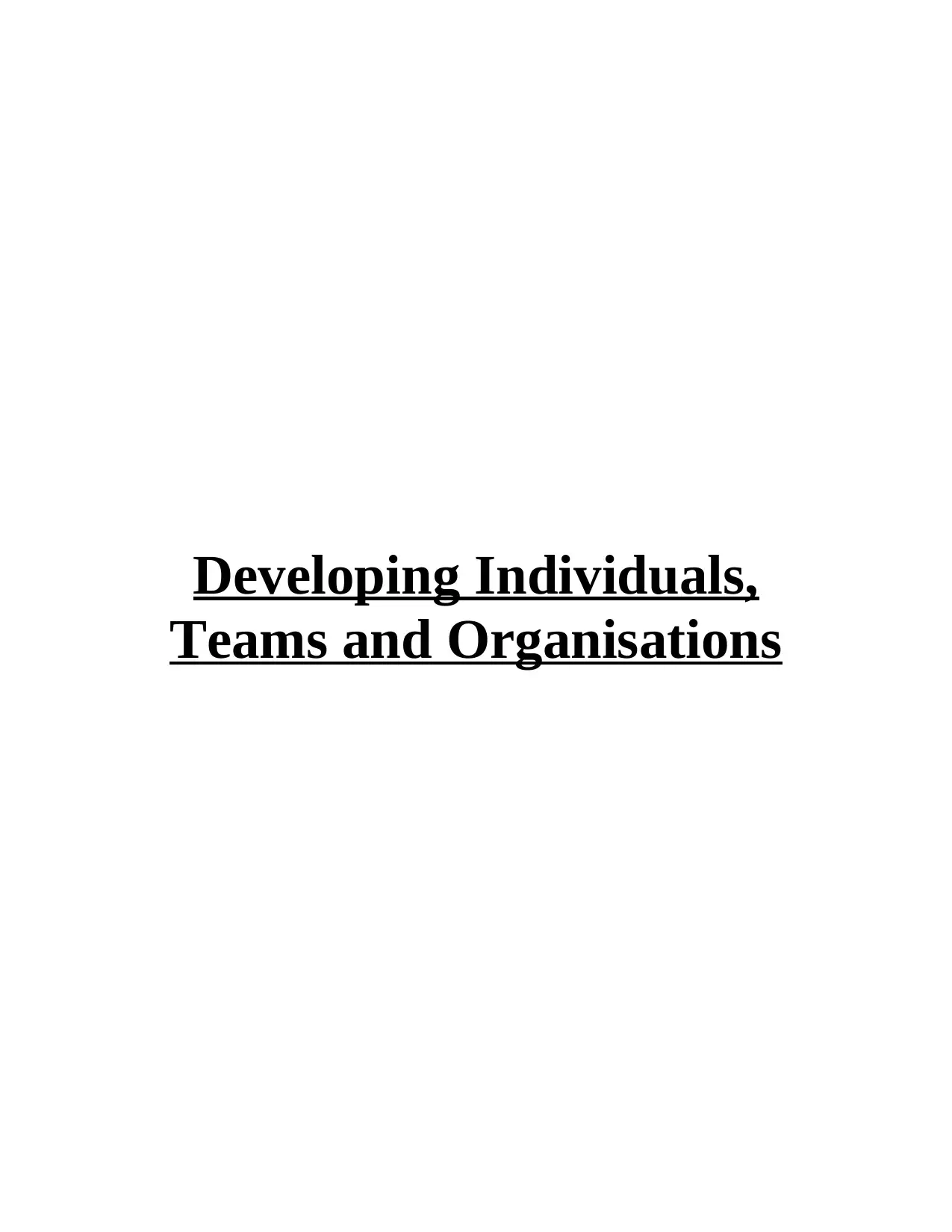
Developing Individuals,
Teams and Organisations
Teams and Organisations
Paraphrase This Document
Need a fresh take? Get an instant paraphrase of this document with our AI Paraphraser
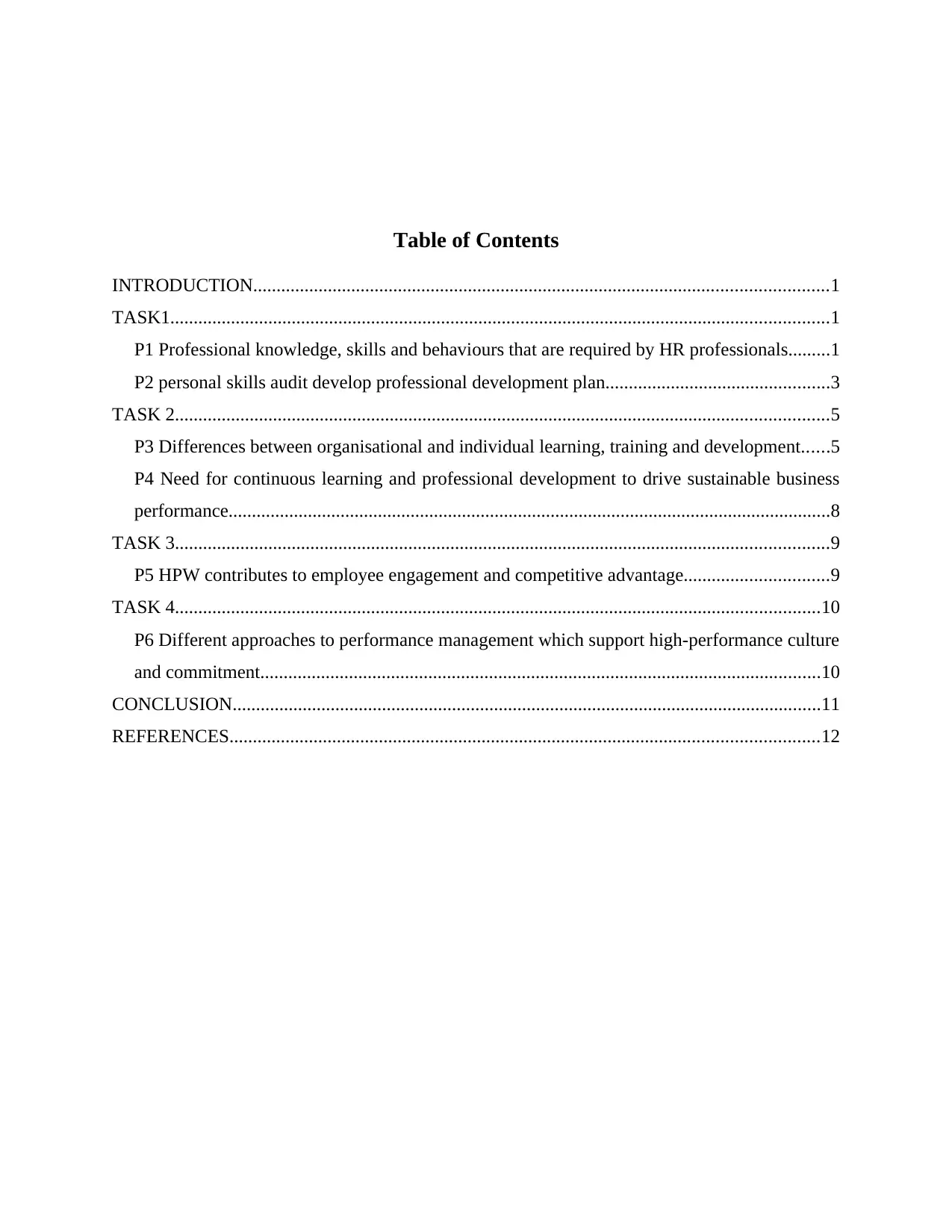
Table of Contents
INTRODUCTION...........................................................................................................................1
TASK1.............................................................................................................................................1
P1 Professional knowledge, skills and behaviours that are required by HR professionals.........1
P2 personal skills audit develop professional development plan................................................3
TASK 2............................................................................................................................................5
P3 Differences between organisational and individual learning, training and development......5
P4 Need for continuous learning and professional development to drive sustainable business
performance.................................................................................................................................8
TASK 3............................................................................................................................................9
P5 HPW contributes to employee engagement and competitive advantage...............................9
TASK 4..........................................................................................................................................10
P6 Different approaches to performance management which support high-performance culture
and commitment........................................................................................................................10
CONCLUSION..............................................................................................................................11
REFERENCES..............................................................................................................................12
INTRODUCTION...........................................................................................................................1
TASK1.............................................................................................................................................1
P1 Professional knowledge, skills and behaviours that are required by HR professionals.........1
P2 personal skills audit develop professional development plan................................................3
TASK 2............................................................................................................................................5
P3 Differences between organisational and individual learning, training and development......5
P4 Need for continuous learning and professional development to drive sustainable business
performance.................................................................................................................................8
TASK 3............................................................................................................................................9
P5 HPW contributes to employee engagement and competitive advantage...............................9
TASK 4..........................................................................................................................................10
P6 Different approaches to performance management which support high-performance culture
and commitment........................................................................................................................10
CONCLUSION..............................................................................................................................11
REFERENCES..............................................................................................................................12

⊘ This is a preview!⊘
Do you want full access?
Subscribe today to unlock all pages.

Trusted by 1+ million students worldwide
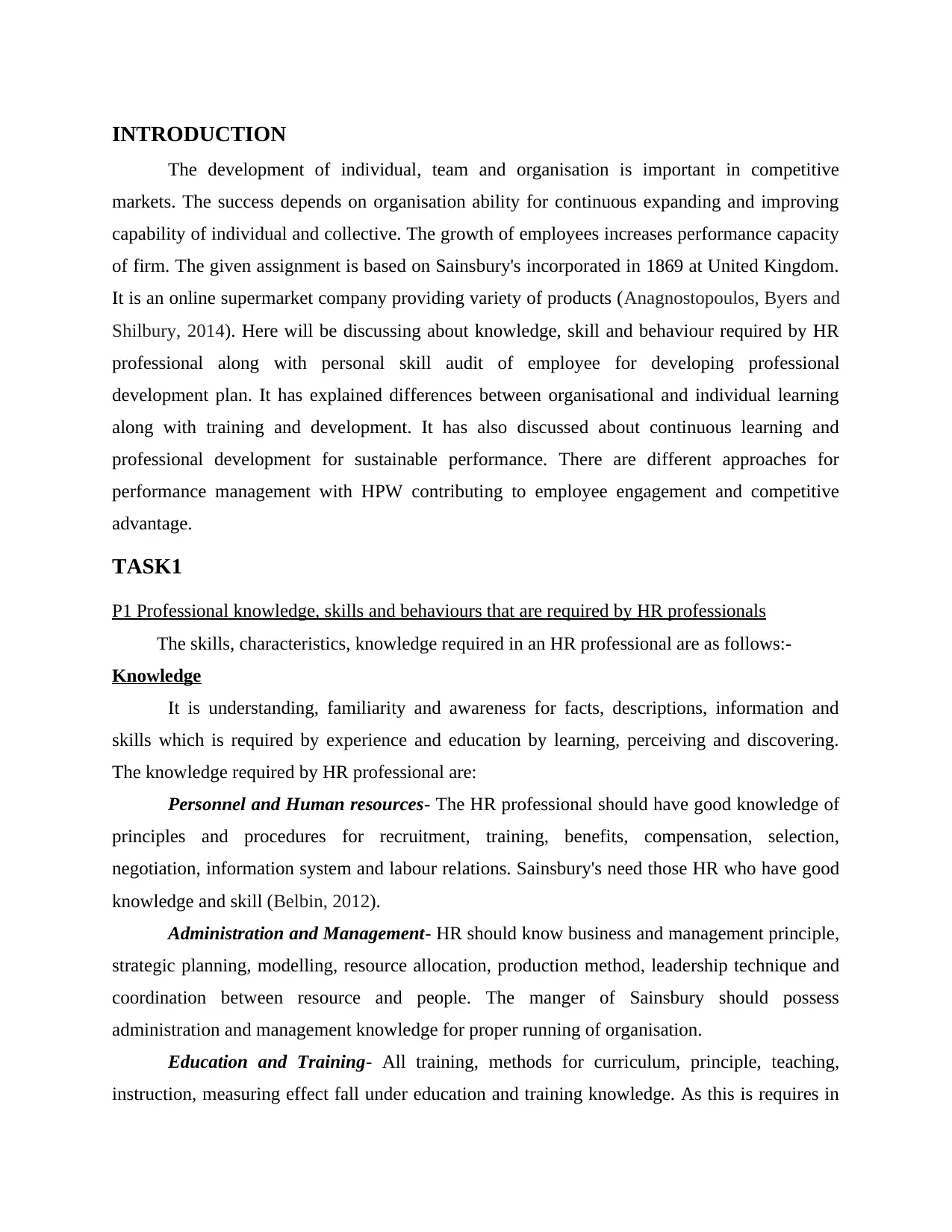
INTRODUCTION
The development of individual, team and organisation is important in competitive
markets. The success depends on organisation ability for continuous expanding and improving
capability of individual and collective. The growth of employees increases performance capacity
of firm. The given assignment is based on Sainsbury's incorporated in 1869 at United Kingdom.
It is an online supermarket company providing variety of products (Anagnostopoulos, Byers and
Shilbury, 2014). Here will be discussing about knowledge, skill and behaviour required by HR
professional along with personal skill audit of employee for developing professional
development plan. It has explained differences between organisational and individual learning
along with training and development. It has also discussed about continuous learning and
professional development for sustainable performance. There are different approaches for
performance management with HPW contributing to employee engagement and competitive
advantage.
TASK1
P1 Professional knowledge, skills and behaviours that are required by HR professionals
The skills, characteristics, knowledge required in an HR professional are as follows:-
Knowledge
It is understanding, familiarity and awareness for facts, descriptions, information and
skills which is required by experience and education by learning, perceiving and discovering.
The knowledge required by HR professional are:
Personnel and Human resources- The HR professional should have good knowledge of
principles and procedures for recruitment, training, benefits, compensation, selection,
negotiation, information system and labour relations. Sainsbury's need those HR who have good
knowledge and skill (Belbin, 2012).
Administration and Management- HR should know business and management principle,
strategic planning, modelling, resource allocation, production method, leadership technique and
coordination between resource and people. The manger of Sainsbury should possess
administration and management knowledge for proper running of organisation.
Education and Training- All training, methods for curriculum, principle, teaching,
instruction, measuring effect fall under education and training knowledge. As this is requires in
The development of individual, team and organisation is important in competitive
markets. The success depends on organisation ability for continuous expanding and improving
capability of individual and collective. The growth of employees increases performance capacity
of firm. The given assignment is based on Sainsbury's incorporated in 1869 at United Kingdom.
It is an online supermarket company providing variety of products (Anagnostopoulos, Byers and
Shilbury, 2014). Here will be discussing about knowledge, skill and behaviour required by HR
professional along with personal skill audit of employee for developing professional
development plan. It has explained differences between organisational and individual learning
along with training and development. It has also discussed about continuous learning and
professional development for sustainable performance. There are different approaches for
performance management with HPW contributing to employee engagement and competitive
advantage.
TASK1
P1 Professional knowledge, skills and behaviours that are required by HR professionals
The skills, characteristics, knowledge required in an HR professional are as follows:-
Knowledge
It is understanding, familiarity and awareness for facts, descriptions, information and
skills which is required by experience and education by learning, perceiving and discovering.
The knowledge required by HR professional are:
Personnel and Human resources- The HR professional should have good knowledge of
principles and procedures for recruitment, training, benefits, compensation, selection,
negotiation, information system and labour relations. Sainsbury's need those HR who have good
knowledge and skill (Belbin, 2012).
Administration and Management- HR should know business and management principle,
strategic planning, modelling, resource allocation, production method, leadership technique and
coordination between resource and people. The manger of Sainsbury should possess
administration and management knowledge for proper running of organisation.
Education and Training- All training, methods for curriculum, principle, teaching,
instruction, measuring effect fall under education and training knowledge. As this is requires in
Paraphrase This Document
Need a fresh take? Get an instant paraphrase of this document with our AI Paraphraser
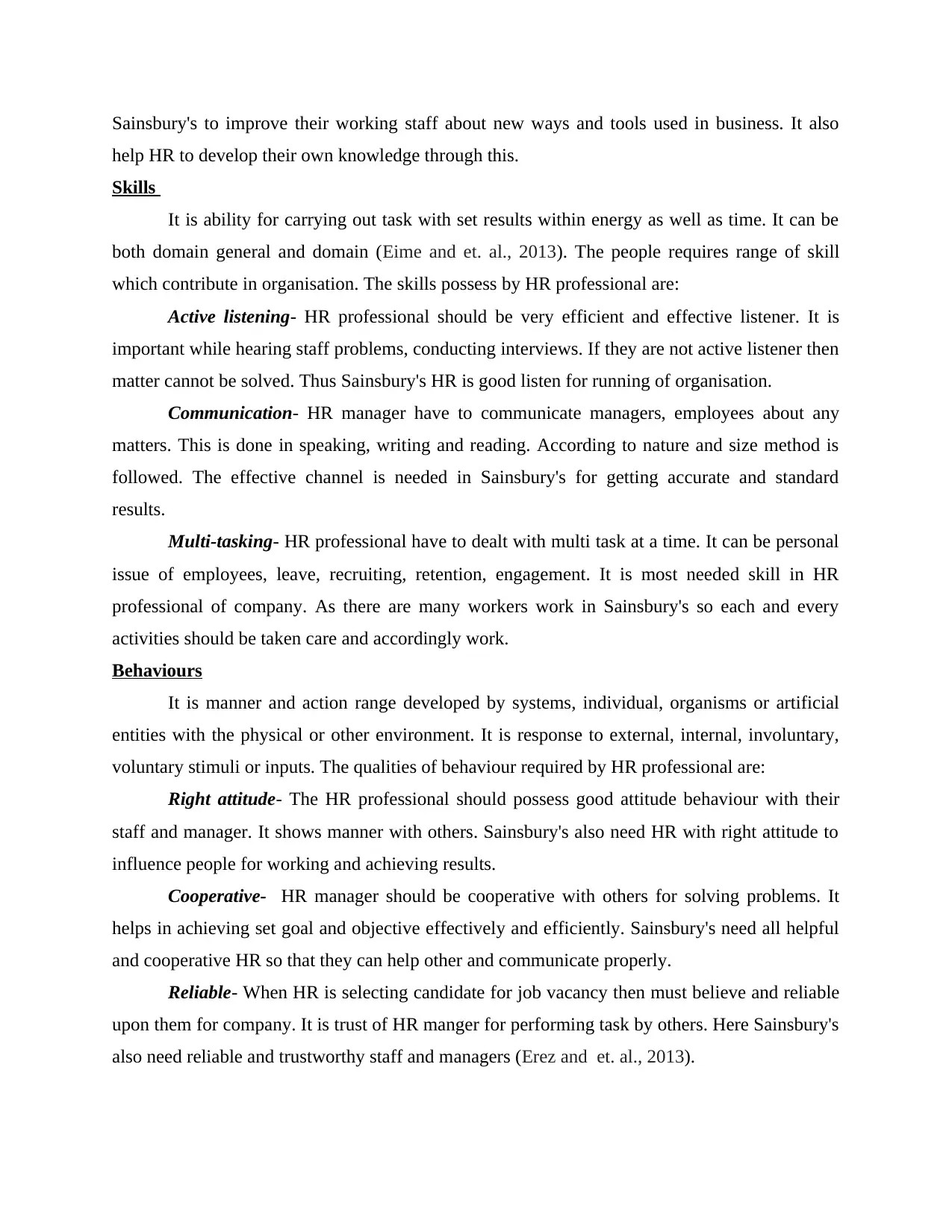
Sainsbury's to improve their working staff about new ways and tools used in business. It also
help HR to develop their own knowledge through this.
Skills
It is ability for carrying out task with set results within energy as well as time. It can be
both domain general and domain (Eime and et. al., 2013). The people requires range of skill
which contribute in organisation. The skills possess by HR professional are:
Active listening- HR professional should be very efficient and effective listener. It is
important while hearing staff problems, conducting interviews. If they are not active listener then
matter cannot be solved. Thus Sainsbury's HR is good listen for running of organisation.
Communication- HR manager have to communicate managers, employees about any
matters. This is done in speaking, writing and reading. According to nature and size method is
followed. The effective channel is needed in Sainsbury's for getting accurate and standard
results.
Multi-tasking- HR professional have to dealt with multi task at a time. It can be personal
issue of employees, leave, recruiting, retention, engagement. It is most needed skill in HR
professional of company. As there are many workers work in Sainsbury's so each and every
activities should be taken care and accordingly work.
Behaviours
It is manner and action range developed by systems, individual, organisms or artificial
entities with the physical or other environment. It is response to external, internal, involuntary,
voluntary stimuli or inputs. The qualities of behaviour required by HR professional are:
Right attitude- The HR professional should possess good attitude behaviour with their
staff and manager. It shows manner with others. Sainsbury's also need HR with right attitude to
influence people for working and achieving results.
Cooperative- HR manager should be cooperative with others for solving problems. It
helps in achieving set goal and objective effectively and efficiently. Sainsbury's need all helpful
and cooperative HR so that they can help other and communicate properly.
Reliable- When HR is selecting candidate for job vacancy then must believe and reliable
upon them for company. It is trust of HR manger for performing task by others. Here Sainsbury's
also need reliable and trustworthy staff and managers (Erez and et. al., 2013).
help HR to develop their own knowledge through this.
Skills
It is ability for carrying out task with set results within energy as well as time. It can be
both domain general and domain (Eime and et. al., 2013). The people requires range of skill
which contribute in organisation. The skills possess by HR professional are:
Active listening- HR professional should be very efficient and effective listener. It is
important while hearing staff problems, conducting interviews. If they are not active listener then
matter cannot be solved. Thus Sainsbury's HR is good listen for running of organisation.
Communication- HR manager have to communicate managers, employees about any
matters. This is done in speaking, writing and reading. According to nature and size method is
followed. The effective channel is needed in Sainsbury's for getting accurate and standard
results.
Multi-tasking- HR professional have to dealt with multi task at a time. It can be personal
issue of employees, leave, recruiting, retention, engagement. It is most needed skill in HR
professional of company. As there are many workers work in Sainsbury's so each and every
activities should be taken care and accordingly work.
Behaviours
It is manner and action range developed by systems, individual, organisms or artificial
entities with the physical or other environment. It is response to external, internal, involuntary,
voluntary stimuli or inputs. The qualities of behaviour required by HR professional are:
Right attitude- The HR professional should possess good attitude behaviour with their
staff and manager. It shows manner with others. Sainsbury's also need HR with right attitude to
influence people for working and achieving results.
Cooperative- HR manager should be cooperative with others for solving problems. It
helps in achieving set goal and objective effectively and efficiently. Sainsbury's need all helpful
and cooperative HR so that they can help other and communicate properly.
Reliable- When HR is selecting candidate for job vacancy then must believe and reliable
upon them for company. It is trust of HR manger for performing task by others. Here Sainsbury's
also need reliable and trustworthy staff and managers (Erez and et. al., 2013).
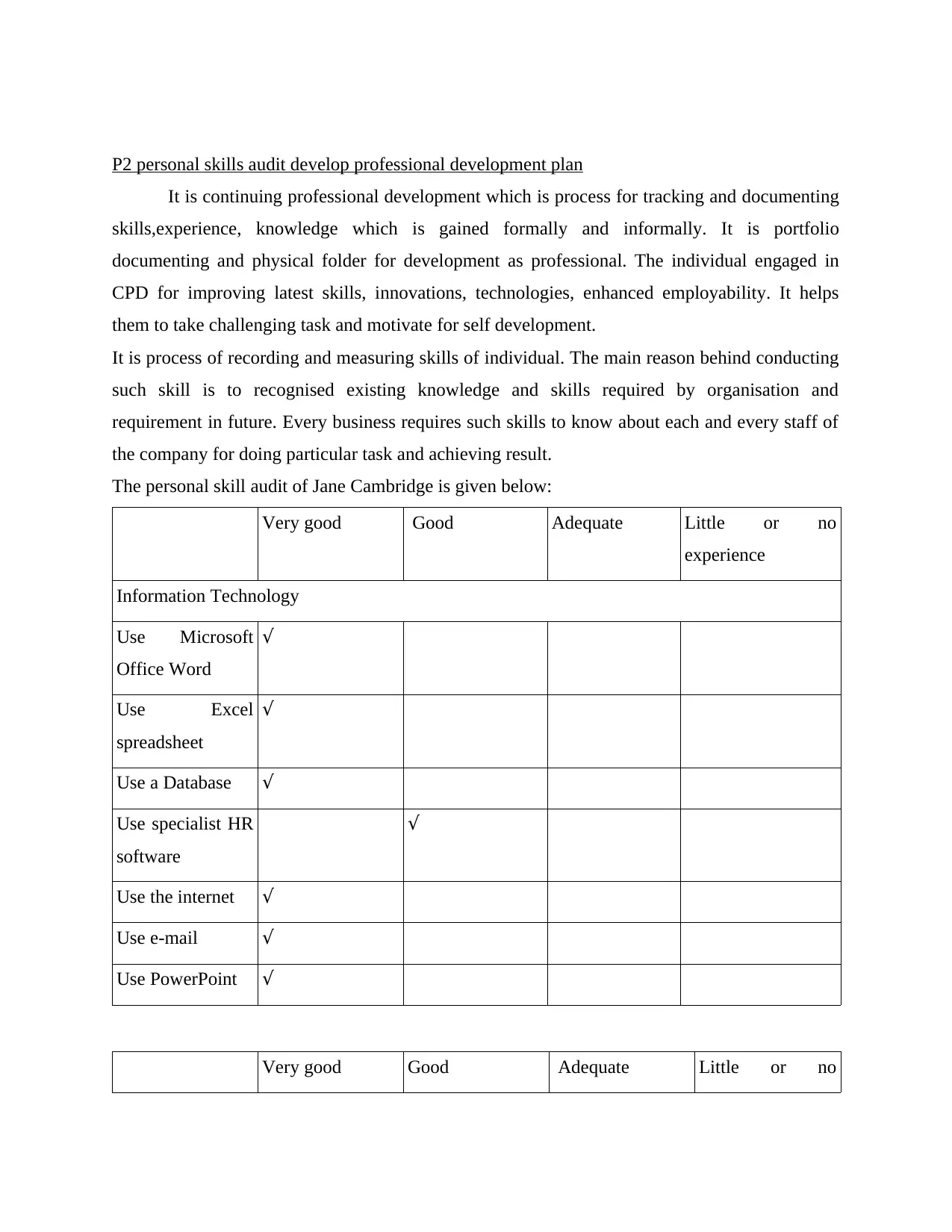
P2 personal skills audit develop professional development plan
It is continuing professional development which is process for tracking and documenting
skills,experience, knowledge which is gained formally and informally. It is portfolio
documenting and physical folder for development as professional. The individual engaged in
CPD for improving latest skills, innovations, technologies, enhanced employability. It helps
them to take challenging task and motivate for self development.
It is process of recording and measuring skills of individual. The main reason behind conducting
such skill is to recognised existing knowledge and skills required by organisation and
requirement in future. Every business requires such skills to know about each and every staff of
the company for doing particular task and achieving result.
The personal skill audit of Jane Cambridge is given below:
Very good Good Adequate Little or no
experience
Information Technology
Use Microsoft
Office Word
√
Use Excel
spreadsheet
√
Use a Database √
Use specialist HR
software
√
Use the internet √
Use e-mail √
Use PowerPoint √
Very good Good Adequate Little or no
It is continuing professional development which is process for tracking and documenting
skills,experience, knowledge which is gained formally and informally. It is portfolio
documenting and physical folder for development as professional. The individual engaged in
CPD for improving latest skills, innovations, technologies, enhanced employability. It helps
them to take challenging task and motivate for self development.
It is process of recording and measuring skills of individual. The main reason behind conducting
such skill is to recognised existing knowledge and skills required by organisation and
requirement in future. Every business requires such skills to know about each and every staff of
the company for doing particular task and achieving result.
The personal skill audit of Jane Cambridge is given below:
Very good Good Adequate Little or no
experience
Information Technology
Use Microsoft
Office Word
√
Use Excel
spreadsheet
√
Use a Database √
Use specialist HR
software
√
Use the internet √
Use e-mail √
Use PowerPoint √
Very good Good Adequate Little or no
⊘ This is a preview!⊘
Do you want full access?
Subscribe today to unlock all pages.

Trusted by 1+ million students worldwide
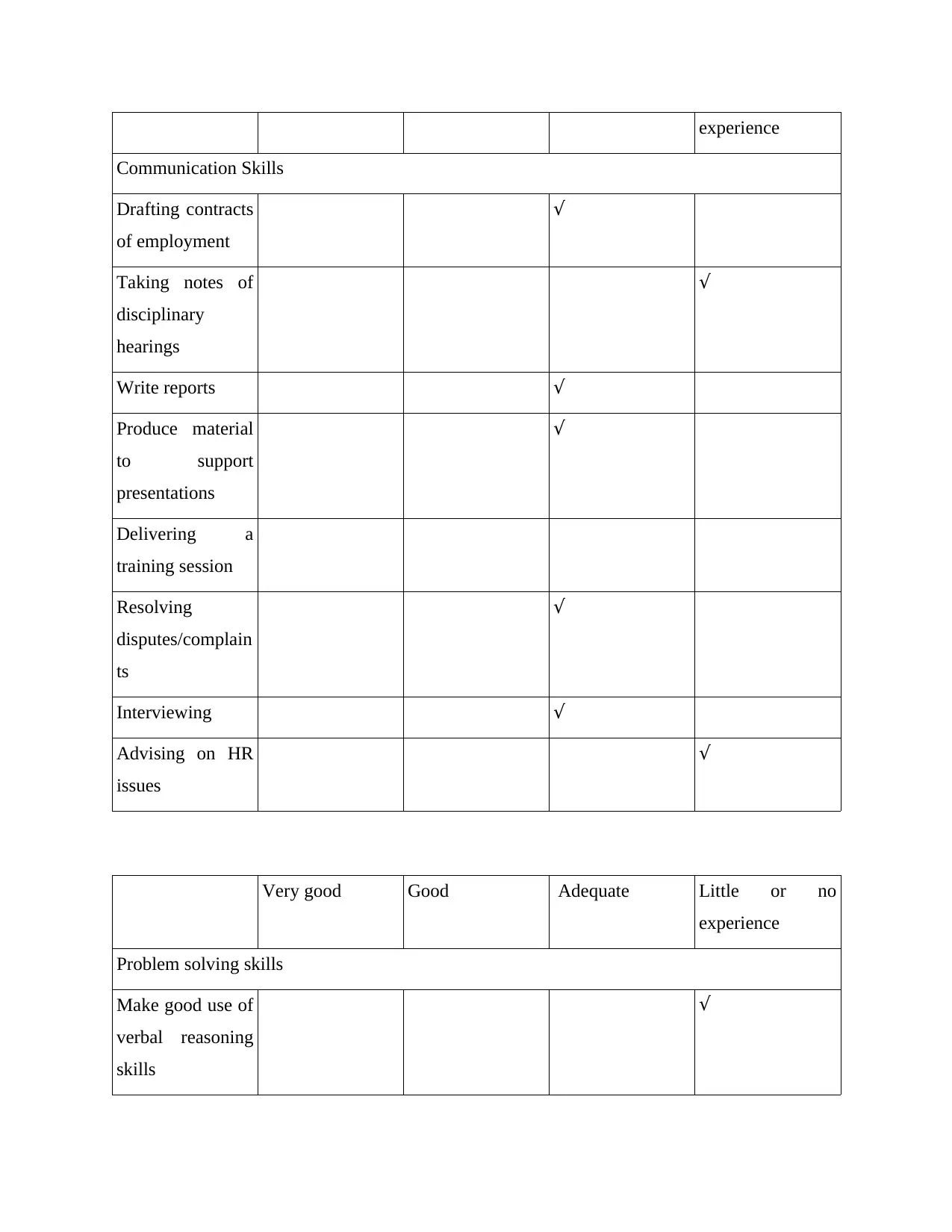
experience
Communication Skills
Drafting contracts
of employment
√
Taking notes of
disciplinary
hearings
√
Write reports √
Produce material
to support
presentations
√
Delivering a
training session
Resolving
disputes/complain
ts
√
Interviewing √
Advising on HR
issues
√
Very good Good Adequate Little or no
experience
Problem solving skills
Make good use of
verbal reasoning
skills
√
Communication Skills
Drafting contracts
of employment
√
Taking notes of
disciplinary
hearings
√
Write reports √
Produce material
to support
presentations
√
Delivering a
training session
Resolving
disputes/complain
ts
√
Interviewing √
Advising on HR
issues
√
Very good Good Adequate Little or no
experience
Problem solving skills
Make good use of
verbal reasoning
skills
√
Paraphrase This Document
Need a fresh take? Get an instant paraphrase of this document with our AI Paraphraser
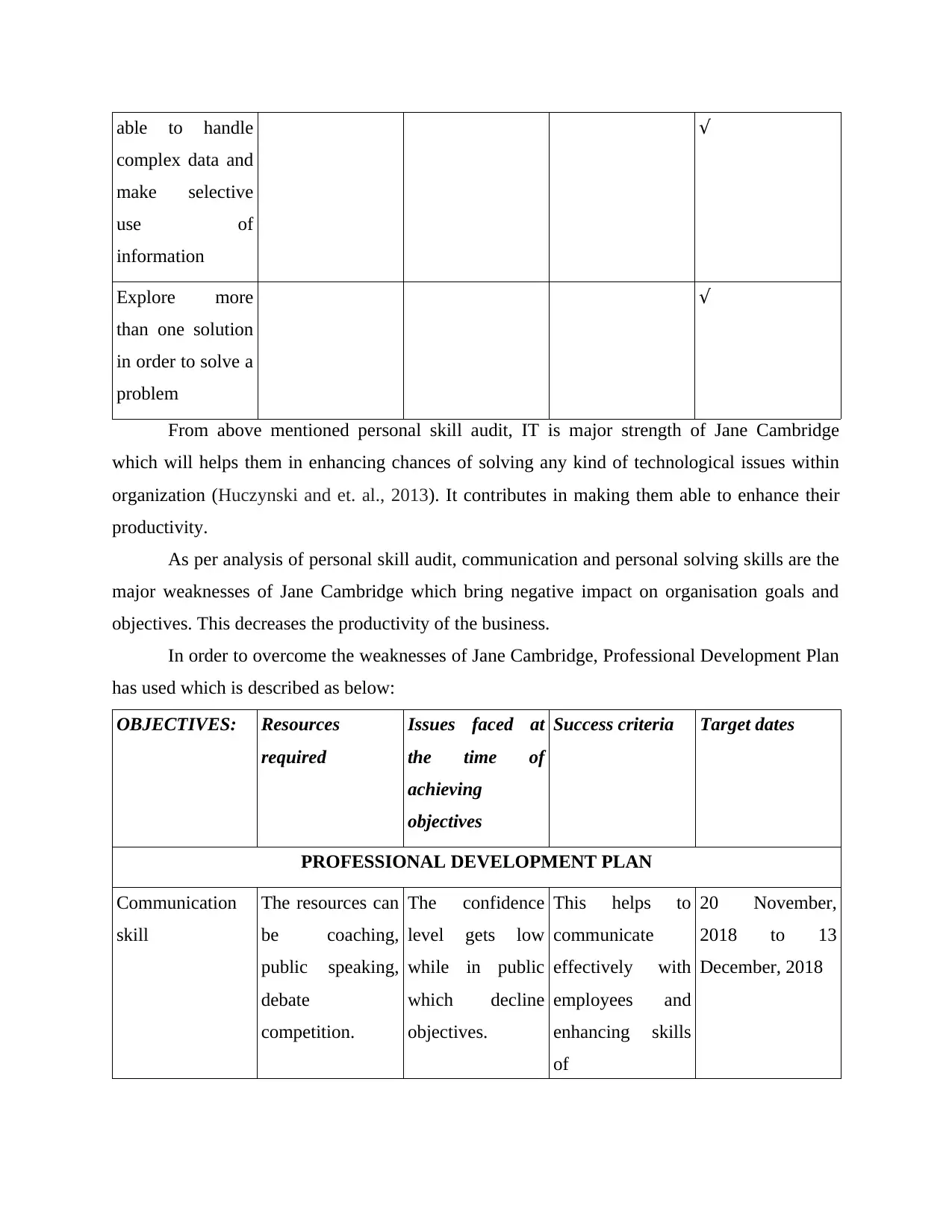
able to handle
complex data and
make selective
use of
information
√
Explore more
than one solution
in order to solve a
problem
√
From above mentioned personal skill audit, IT is major strength of Jane Cambridge
which will helps them in enhancing chances of solving any kind of technological issues within
organization (Huczynski and et. al., 2013). It contributes in making them able to enhance their
productivity.
As per analysis of personal skill audit, communication and personal solving skills are the
major weaknesses of Jane Cambridge which bring negative impact on organisation goals and
objectives. This decreases the productivity of the business.
In order to overcome the weaknesses of Jane Cambridge, Professional Development Plan
has used which is described as below:
OBJECTIVES: Resources
required
Issues faced at
the time of
achieving
objectives
Success criteria Target dates
PROFESSIONAL DEVELOPMENT PLAN
Communication
skill
The resources can
be coaching,
public speaking,
debate
competition.
The confidence
level gets low
while in public
which decline
objectives.
This helps to
communicate
effectively with
employees and
enhancing skills
of
20 November,
2018 to 13
December, 2018
complex data and
make selective
use of
information
√
Explore more
than one solution
in order to solve a
problem
√
From above mentioned personal skill audit, IT is major strength of Jane Cambridge
which will helps them in enhancing chances of solving any kind of technological issues within
organization (Huczynski and et. al., 2013). It contributes in making them able to enhance their
productivity.
As per analysis of personal skill audit, communication and personal solving skills are the
major weaknesses of Jane Cambridge which bring negative impact on organisation goals and
objectives. This decreases the productivity of the business.
In order to overcome the weaknesses of Jane Cambridge, Professional Development Plan
has used which is described as below:
OBJECTIVES: Resources
required
Issues faced at
the time of
achieving
objectives
Success criteria Target dates
PROFESSIONAL DEVELOPMENT PLAN
Communication
skill
The resources can
be coaching,
public speaking,
debate
competition.
The confidence
level gets low
while in public
which decline
objectives.
This helps to
communicate
effectively with
employees and
enhancing skills
of
20 November,
2018 to 13
December, 2018
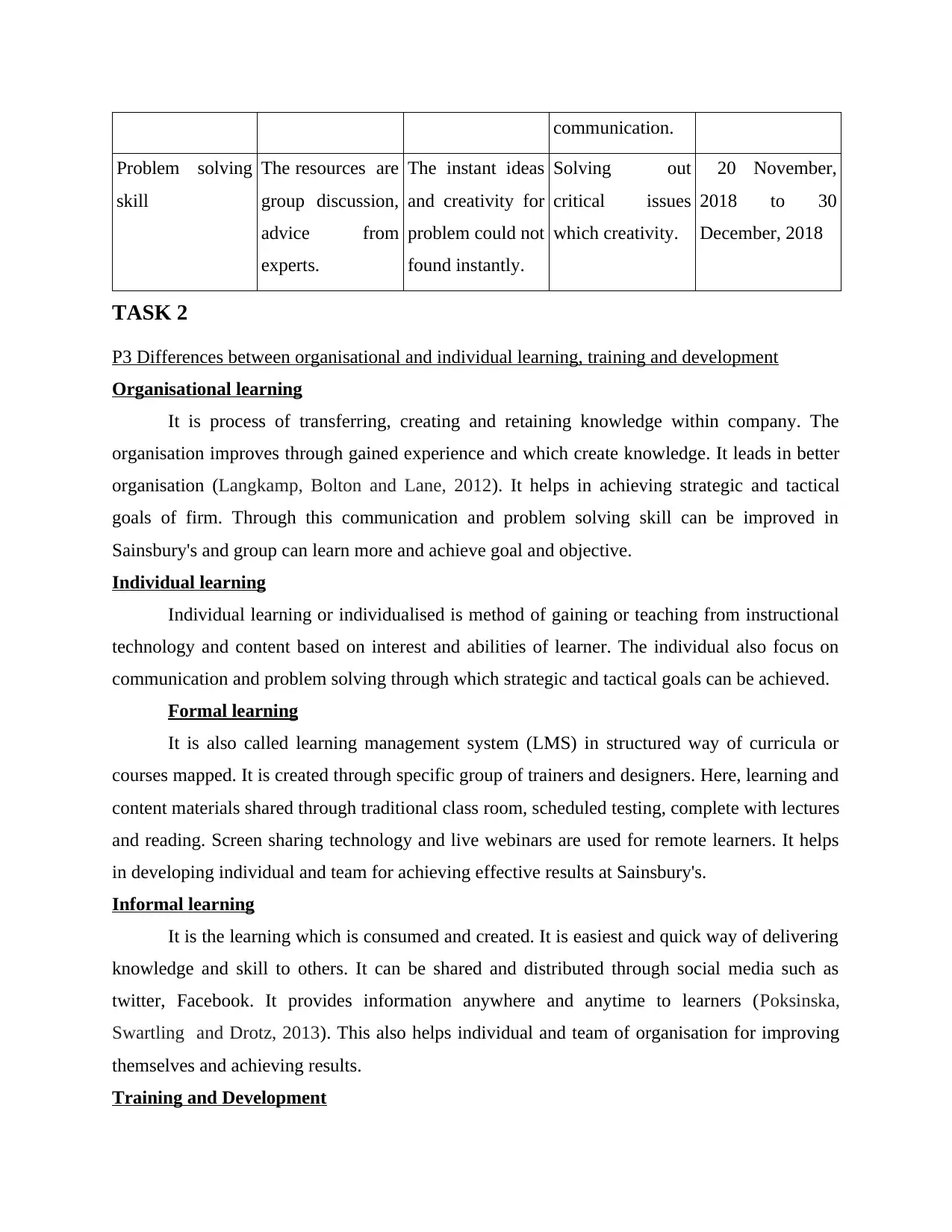
communication.
Problem solving
skill
The resources are
group discussion,
advice from
experts.
The instant ideas
and creativity for
problem could not
found instantly.
Solving out
critical issues
which creativity.
20 November,
2018 to 30
December, 2018
TASK 2
P3 Differences between organisational and individual learning, training and development
Organisational learning
It is process of transferring, creating and retaining knowledge within company. The
organisation improves through gained experience and which create knowledge. It leads in better
organisation (Langkamp, Bolton and Lane, 2012). It helps in achieving strategic and tactical
goals of firm. Through this communication and problem solving skill can be improved in
Sainsbury's and group can learn more and achieve goal and objective.
Individual learning
Individual learning or individualised is method of gaining or teaching from instructional
technology and content based on interest and abilities of learner. The individual also focus on
communication and problem solving through which strategic and tactical goals can be achieved.
Formal learning
It is also called learning management system (LMS) in structured way of curricula or
courses mapped. It is created through specific group of trainers and designers. Here, learning and
content materials shared through traditional class room, scheduled testing, complete with lectures
and reading. Screen sharing technology and live webinars are used for remote learners. It helps
in developing individual and team for achieving effective results at Sainsbury's.
Informal learning
It is the learning which is consumed and created. It is easiest and quick way of delivering
knowledge and skill to others. It can be shared and distributed through social media such as
twitter, Facebook. It provides information anywhere and anytime to learners (Poksinska,
Swartling and Drotz, 2013). This also helps individual and team of organisation for improving
themselves and achieving results.
Training and Development
Problem solving
skill
The resources are
group discussion,
advice from
experts.
The instant ideas
and creativity for
problem could not
found instantly.
Solving out
critical issues
which creativity.
20 November,
2018 to 30
December, 2018
TASK 2
P3 Differences between organisational and individual learning, training and development
Organisational learning
It is process of transferring, creating and retaining knowledge within company. The
organisation improves through gained experience and which create knowledge. It leads in better
organisation (Langkamp, Bolton and Lane, 2012). It helps in achieving strategic and tactical
goals of firm. Through this communication and problem solving skill can be improved in
Sainsbury's and group can learn more and achieve goal and objective.
Individual learning
Individual learning or individualised is method of gaining or teaching from instructional
technology and content based on interest and abilities of learner. The individual also focus on
communication and problem solving through which strategic and tactical goals can be achieved.
Formal learning
It is also called learning management system (LMS) in structured way of curricula or
courses mapped. It is created through specific group of trainers and designers. Here, learning and
content materials shared through traditional class room, scheduled testing, complete with lectures
and reading. Screen sharing technology and live webinars are used for remote learners. It helps
in developing individual and team for achieving effective results at Sainsbury's.
Informal learning
It is the learning which is consumed and created. It is easiest and quick way of delivering
knowledge and skill to others. It can be shared and distributed through social media such as
twitter, Facebook. It provides information anywhere and anytime to learners (Poksinska,
Swartling and Drotz, 2013). This also helps individual and team of organisation for improving
themselves and achieving results.
Training and Development
⊘ This is a preview!⊘
Do you want full access?
Subscribe today to unlock all pages.

Trusted by 1+ million students worldwide
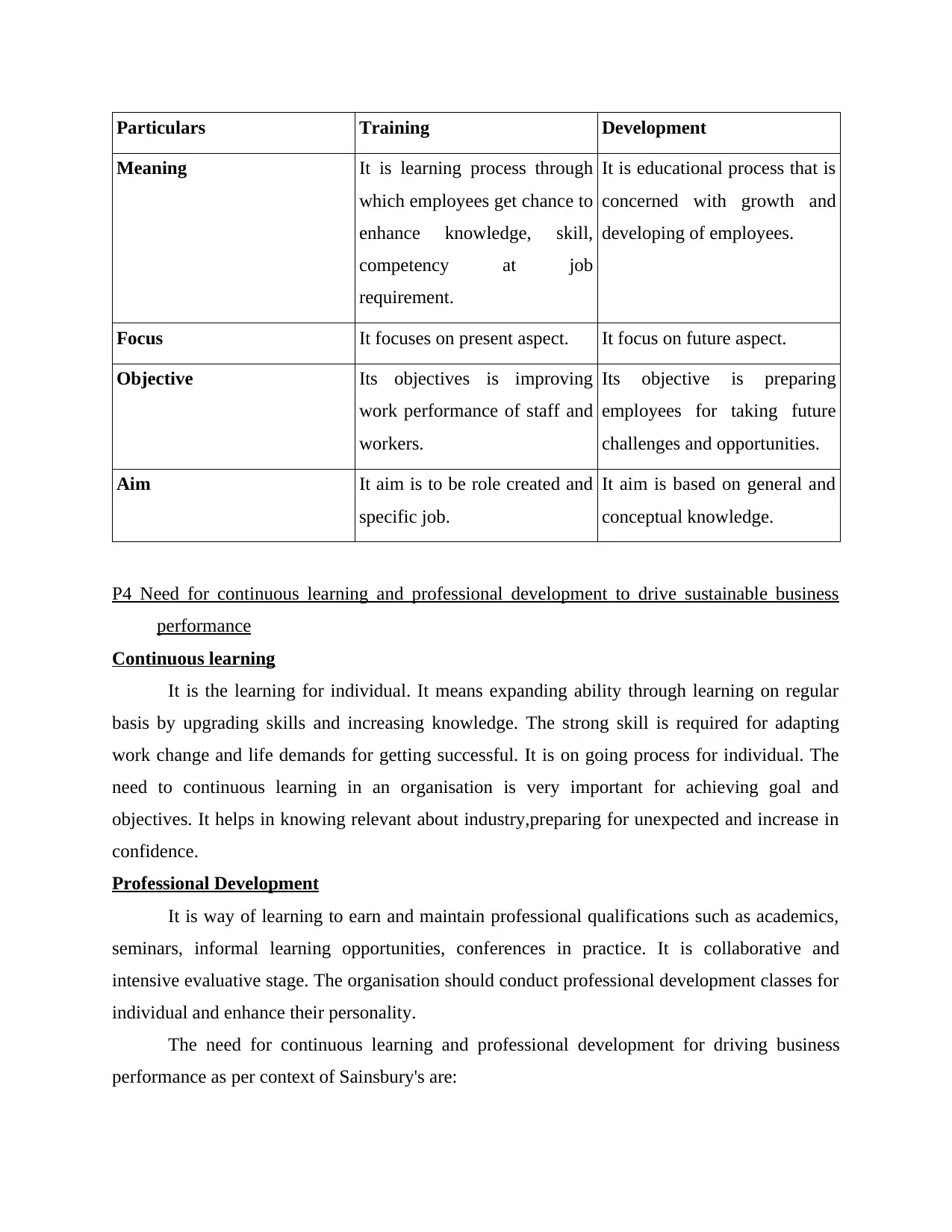
Particulars Training Development
Meaning It is learning process through
which employees get chance to
enhance knowledge, skill,
competency at job
requirement.
It is educational process that is
concerned with growth and
developing of employees.
Focus It focuses on present aspect. It focus on future aspect.
Objective Its objectives is improving
work performance of staff and
workers.
Its objective is preparing
employees for taking future
challenges and opportunities.
Aim It aim is to be role created and
specific job.
It aim is based on general and
conceptual knowledge.
P4 Need for continuous learning and professional development to drive sustainable business
performance
Continuous learning
It is the learning for individual. It means expanding ability through learning on regular
basis by upgrading skills and increasing knowledge. The strong skill is required for adapting
work change and life demands for getting successful. It is on going process for individual. The
need to continuous learning in an organisation is very important for achieving goal and
objectives. It helps in knowing relevant about industry,preparing for unexpected and increase in
confidence.
Professional Development
It is way of learning to earn and maintain professional qualifications such as academics,
seminars, informal learning opportunities, conferences in practice. It is collaborative and
intensive evaluative stage. The organisation should conduct professional development classes for
individual and enhance their personality.
The need for continuous learning and professional development for driving business
performance as per context of Sainsbury's are:
Meaning It is learning process through
which employees get chance to
enhance knowledge, skill,
competency at job
requirement.
It is educational process that is
concerned with growth and
developing of employees.
Focus It focuses on present aspect. It focus on future aspect.
Objective Its objectives is improving
work performance of staff and
workers.
Its objective is preparing
employees for taking future
challenges and opportunities.
Aim It aim is to be role created and
specific job.
It aim is based on general and
conceptual knowledge.
P4 Need for continuous learning and professional development to drive sustainable business
performance
Continuous learning
It is the learning for individual. It means expanding ability through learning on regular
basis by upgrading skills and increasing knowledge. The strong skill is required for adapting
work change and life demands for getting successful. It is on going process for individual. The
need to continuous learning in an organisation is very important for achieving goal and
objectives. It helps in knowing relevant about industry,preparing for unexpected and increase in
confidence.
Professional Development
It is way of learning to earn and maintain professional qualifications such as academics,
seminars, informal learning opportunities, conferences in practice. It is collaborative and
intensive evaluative stage. The organisation should conduct professional development classes for
individual and enhance their personality.
The need for continuous learning and professional development for driving business
performance as per context of Sainsbury's are:
Paraphrase This Document
Need a fresh take? Get an instant paraphrase of this document with our AI Paraphraser
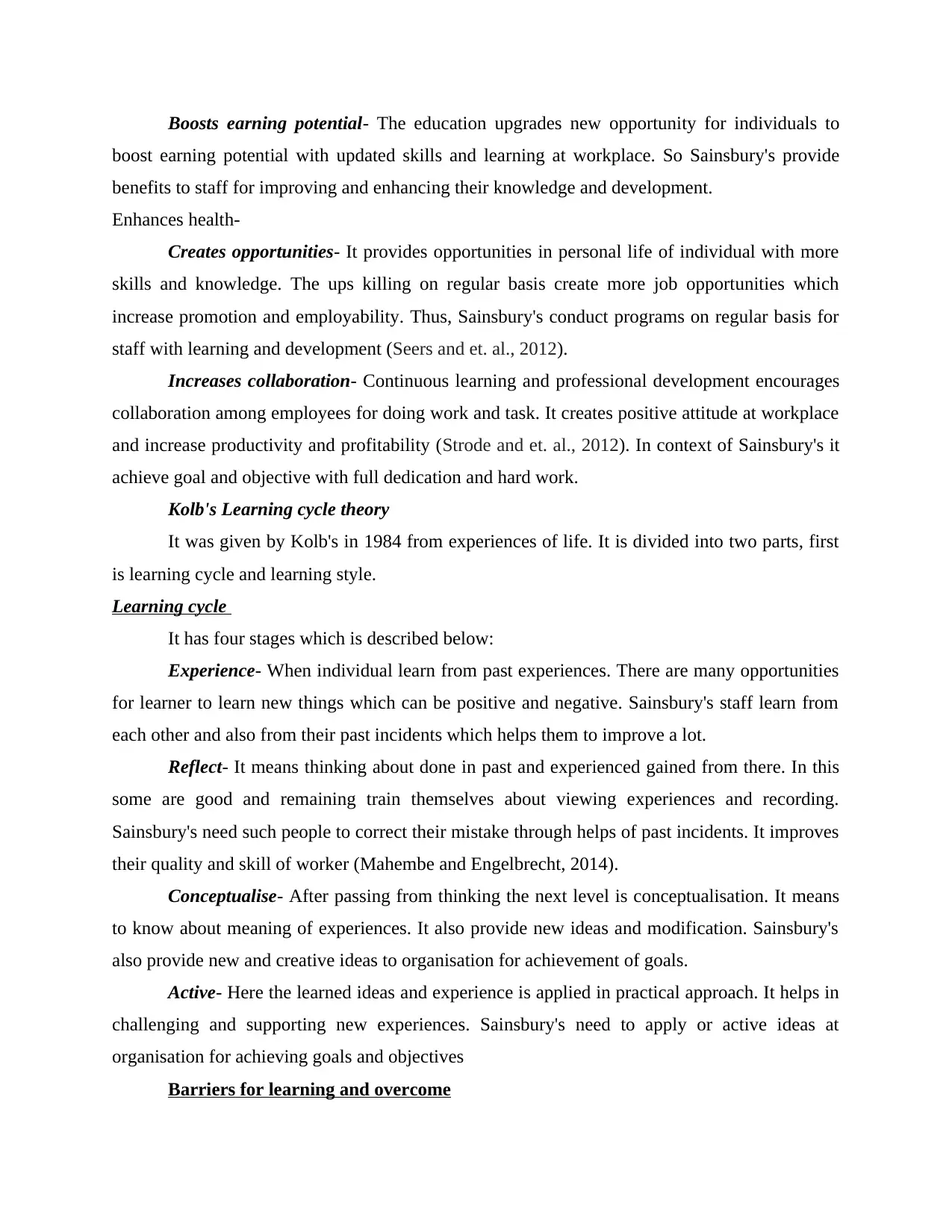
Boosts earning potential- The education upgrades new opportunity for individuals to
boost earning potential with updated skills and learning at workplace. So Sainsbury's provide
benefits to staff for improving and enhancing their knowledge and development.
Enhances health-
Creates opportunities- It provides opportunities in personal life of individual with more
skills and knowledge. The ups killing on regular basis create more job opportunities which
increase promotion and employability. Thus, Sainsbury's conduct programs on regular basis for
staff with learning and development (Seers and et. al., 2012).
Increases collaboration- Continuous learning and professional development encourages
collaboration among employees for doing work and task. It creates positive attitude at workplace
and increase productivity and profitability (Strode and et. al., 2012). In context of Sainsbury's it
achieve goal and objective with full dedication and hard work.
Kolb's Learning cycle theory
It was given by Kolb's in 1984 from experiences of life. It is divided into two parts, first
is learning cycle and learning style.
Learning cycle
It has four stages which is described below:
Experience- When individual learn from past experiences. There are many opportunities
for learner to learn new things which can be positive and negative. Sainsbury's staff learn from
each other and also from their past incidents which helps them to improve a lot.
Reflect- It means thinking about done in past and experienced gained from there. In this
some are good and remaining train themselves about viewing experiences and recording.
Sainsbury's need such people to correct their mistake through helps of past incidents. It improves
their quality and skill of worker (Mahembe and Engelbrecht, 2014).
Conceptualise- After passing from thinking the next level is conceptualisation. It means
to know about meaning of experiences. It also provide new ideas and modification. Sainsbury's
also provide new and creative ideas to organisation for achievement of goals.
Active- Here the learned ideas and experience is applied in practical approach. It helps in
challenging and supporting new experiences. Sainsbury's need to apply or active ideas at
organisation for achieving goals and objectives
Barriers for learning and overcome
boost earning potential with updated skills and learning at workplace. So Sainsbury's provide
benefits to staff for improving and enhancing their knowledge and development.
Enhances health-
Creates opportunities- It provides opportunities in personal life of individual with more
skills and knowledge. The ups killing on regular basis create more job opportunities which
increase promotion and employability. Thus, Sainsbury's conduct programs on regular basis for
staff with learning and development (Seers and et. al., 2012).
Increases collaboration- Continuous learning and professional development encourages
collaboration among employees for doing work and task. It creates positive attitude at workplace
and increase productivity and profitability (Strode and et. al., 2012). In context of Sainsbury's it
achieve goal and objective with full dedication and hard work.
Kolb's Learning cycle theory
It was given by Kolb's in 1984 from experiences of life. It is divided into two parts, first
is learning cycle and learning style.
Learning cycle
It has four stages which is described below:
Experience- When individual learn from past experiences. There are many opportunities
for learner to learn new things which can be positive and negative. Sainsbury's staff learn from
each other and also from their past incidents which helps them to improve a lot.
Reflect- It means thinking about done in past and experienced gained from there. In this
some are good and remaining train themselves about viewing experiences and recording.
Sainsbury's need such people to correct their mistake through helps of past incidents. It improves
their quality and skill of worker (Mahembe and Engelbrecht, 2014).
Conceptualise- After passing from thinking the next level is conceptualisation. It means
to know about meaning of experiences. It also provide new ideas and modification. Sainsbury's
also provide new and creative ideas to organisation for achievement of goals.
Active- Here the learned ideas and experience is applied in practical approach. It helps in
challenging and supporting new experiences. Sainsbury's need to apply or active ideas at
organisation for achieving goals and objectives
Barriers for learning and overcome
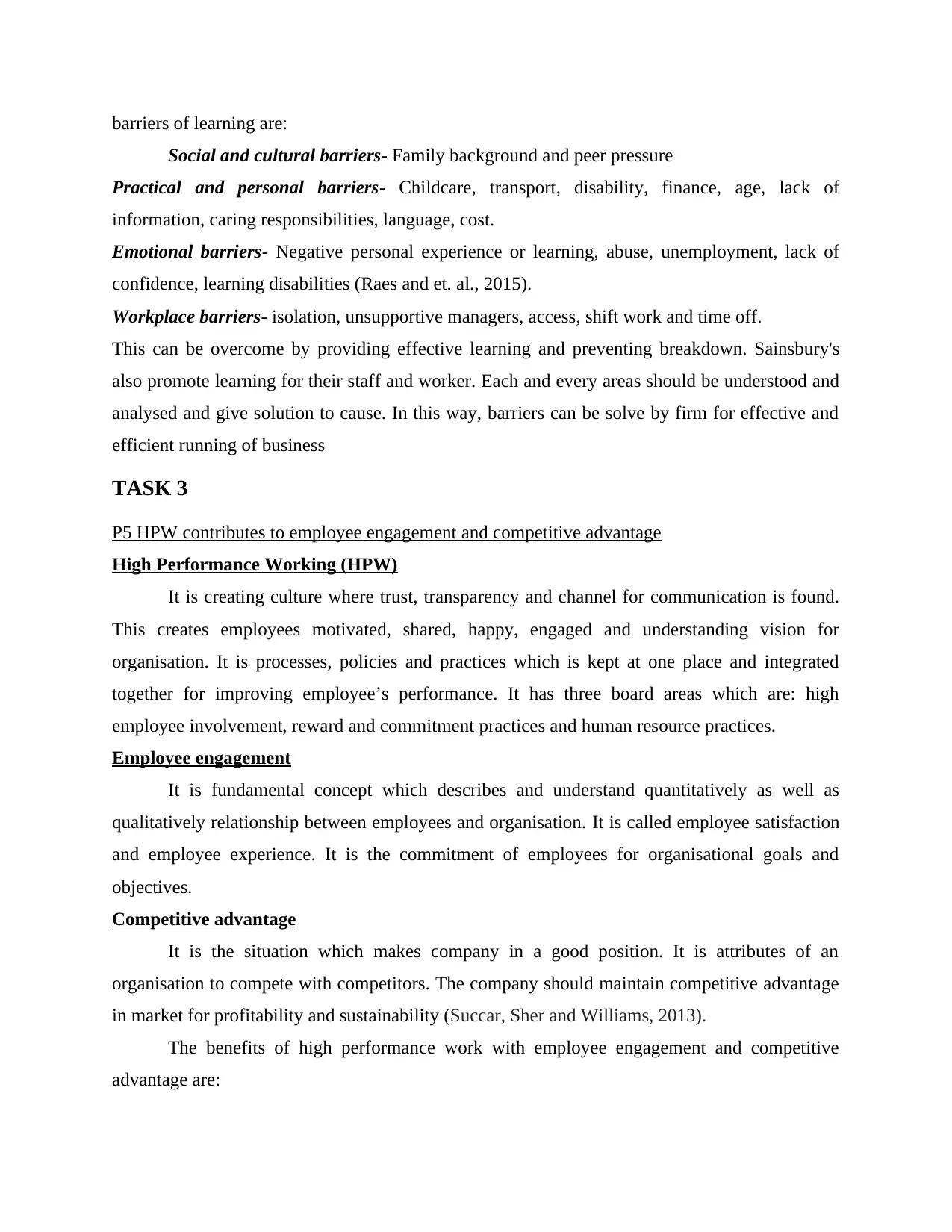
barriers of learning are:
Social and cultural barriers- Family background and peer pressure
Practical and personal barriers- Childcare, transport, disability, finance, age, lack of
information, caring responsibilities, language, cost.
Emotional barriers- Negative personal experience or learning, abuse, unemployment, lack of
confidence, learning disabilities (Raes and et. al., 2015).
Workplace barriers- isolation, unsupportive managers, access, shift work and time off.
This can be overcome by providing effective learning and preventing breakdown. Sainsbury's
also promote learning for their staff and worker. Each and every areas should be understood and
analysed and give solution to cause. In this way, barriers can be solve by firm for effective and
efficient running of business
TASK 3
P5 HPW contributes to employee engagement and competitive advantage
High Performance Working (HPW)
It is creating culture where trust, transparency and channel for communication is found.
This creates employees motivated, shared, happy, engaged and understanding vision for
organisation. It is processes, policies and practices which is kept at one place and integrated
together for improving employee’s performance. It has three board areas which are: high
employee involvement, reward and commitment practices and human resource practices.
Employee engagement
It is fundamental concept which describes and understand quantitatively as well as
qualitatively relationship between employees and organisation. It is called employee satisfaction
and employee experience. It is the commitment of employees for organisational goals and
objectives.
Competitive advantage
It is the situation which makes company in a good position. It is attributes of an
organisation to compete with competitors. The company should maintain competitive advantage
in market for profitability and sustainability (Succar, Sher and Williams, 2013).
The benefits of high performance work with employee engagement and competitive
advantage are:
Social and cultural barriers- Family background and peer pressure
Practical and personal barriers- Childcare, transport, disability, finance, age, lack of
information, caring responsibilities, language, cost.
Emotional barriers- Negative personal experience or learning, abuse, unemployment, lack of
confidence, learning disabilities (Raes and et. al., 2015).
Workplace barriers- isolation, unsupportive managers, access, shift work and time off.
This can be overcome by providing effective learning and preventing breakdown. Sainsbury's
also promote learning for their staff and worker. Each and every areas should be understood and
analysed and give solution to cause. In this way, barriers can be solve by firm for effective and
efficient running of business
TASK 3
P5 HPW contributes to employee engagement and competitive advantage
High Performance Working (HPW)
It is creating culture where trust, transparency and channel for communication is found.
This creates employees motivated, shared, happy, engaged and understanding vision for
organisation. It is processes, policies and practices which is kept at one place and integrated
together for improving employee’s performance. It has three board areas which are: high
employee involvement, reward and commitment practices and human resource practices.
Employee engagement
It is fundamental concept which describes and understand quantitatively as well as
qualitatively relationship between employees and organisation. It is called employee satisfaction
and employee experience. It is the commitment of employees for organisational goals and
objectives.
Competitive advantage
It is the situation which makes company in a good position. It is attributes of an
organisation to compete with competitors. The company should maintain competitive advantage
in market for profitability and sustainability (Succar, Sher and Williams, 2013).
The benefits of high performance work with employee engagement and competitive
advantage are:
⊘ This is a preview!⊘
Do you want full access?
Subscribe today to unlock all pages.

Trusted by 1+ million students worldwide
1 out of 16
Related Documents
Your All-in-One AI-Powered Toolkit for Academic Success.
+13062052269
info@desklib.com
Available 24*7 on WhatsApp / Email
![[object Object]](/_next/static/media/star-bottom.7253800d.svg)
Unlock your academic potential
Copyright © 2020–2025 A2Z Services. All Rights Reserved. Developed and managed by ZUCOL.





